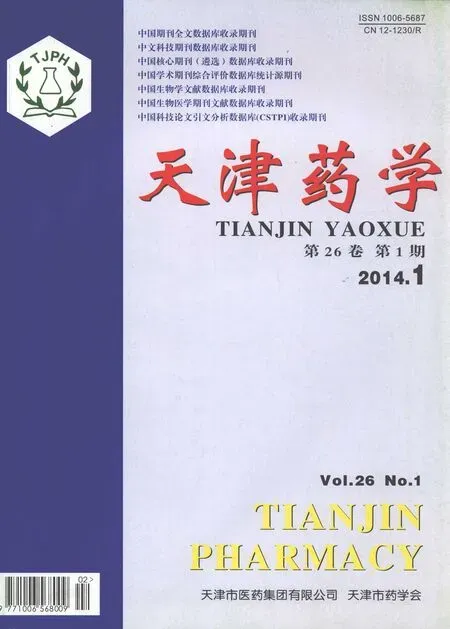线粒体在心肌保护中作用的研究进展*
2014-02-11高建波
高建波
(天津市药品检验所,天津300070)
线粒体在心肌保护中作用的研究进展*
高建波
(天津市药品检验所,天津300070)
线粒体是细胞内重要的细胞器,三羧酸循环、电子传递和氧化磷酸化均在线粒体中进行,是细胞中心代谢途径的核心。在生理情况下,其是细胞的能量加工器,维持细胞的正常能量代谢和存活;在缺血再灌注情况下线粒体功能发生紊乱,转而促进细胞的坏死和凋亡。对心肌损伤机制的研究表明,线粒体的功能损害是导致缺血再灌注心肌不可逆损伤的重要原因之一。所以,线粒体保护成为解决心肌损伤的重要途径之一。大量研究表明,线粒体ATP敏感性钾通道、线粒体通透性转换孔、线粒体型硫氧还蛋白、线粒体钙激活钾通道、缝隙连接蛋白43在线粒体的心肌保护中发挥着重要作用。本文就近年来线粒体在心肌保护中的作用研究进展做一综述。
线粒体,心肌保护,通道,蛋白质
对于缺血心肌保护的研究一直是心血管领域的重点,而线粒体作为细胞中的能量代谢中心,在心肌保护中的作用日益受到重视。对心肌的保护研究逐渐趋向于线粒体功能保护,大量研究表明,线粒体保护在心肌保护中具有非常重要的意义。其中,线粒体ATP敏感性钾通道(mitochondrial ATP-sensitive potassium channels,mitoKATP)、线粒体通透性转换孔(mitochondrial permeability transition pore,MPTP)、线粒体型硫氧还蛋白(thioredoxin 2,Trx2)、线粒体钙激活钾通道(mitochondrial Ca2+-activated K+channels,mitoKCa)、线粒体缝隙连接蛋白43(connexin 43,Cx 43)在线粒体的心肌保护中发挥至关重要的作用。本文对其近年来的研究情况进行了综述。
1 线粒体ATP敏感性钾通道与心肌保护
mitoKATP是由内向整流钾通道(inwardly rectified potassium channel,Kir)和ATP结合组件(ATP-binding cassette,ABC)组成。前者形成离子通道,后者决定KATP功能。mitoKATP主要的生理功能:一是通过维持线粒体内K+平衡状态调节线粒体容积,进而保护细胞;二是在线粒体氧化磷酸化过程中摄取K+可以部分弥补因质子泵转运H+引起的电荷变化,从而维持一定的线粒体跨膜电位和pH梯度的稳态[1,2]。mitoKATP的开放在心肌保护中起重要作用。多项研究结果表明,其特异开放剂二氮嗪预处理缩小了缺血再灌注(ischemia reperfusion,I/R)心肌的梗死面积,缺血预适应(ischemic preconditioning,IPC)减少心肌细胞凋亡,减轻再灌注后心律失常及心肌梗死等作用都是通过开放mitoKATP才得以实现,而用通道特异性阻断剂5-HD抑制其开放则可以完全取消IPC的心肌保护作用[3,4]。
目前认为,mitoKATP通道主要通过以下机制发挥心肌保护作用:①减轻I/R心肌的钙超载。mitoKATP开放后从两方面降低了线粒体内的钙超载,一是线粒体内膜电位下降,而线粒体膜电位的降低有助于抑制Ca2+内流,导致钙摄入减少,从而有效防止线粒体内钙超载;二是mitoKATP开放后部分Ca2+从线粒体内进入胞浆,从而降低了线粒体内Ca2+的浓度[5,6]。②增加了线粒体的基质容积。mitoKATP的开放促进了K+内流,同时伴随有其他阴、阳离子的进入,最后达到渗透压和电位平衡,此过程伴有水分的进入,其结果是线粒体基质肿胀、容积增加,激活电子传递链,对抗了基质减少及其所引起的呼吸抑制,促进能量代谢,促进线粒体呼吸和增加净氧化,减少ATP的水解及提高了多种酶的活性。同时,mitoKATP的开放,也导致线粒体部分脱耦联,使氧化磷酸化达到最佳效率,增加ATP合成,提高线粒体功能。在线粒体K+内流的同时,伴有阴离子的外流,以平衡K+的内流,这种平衡使线粒体基质容积达到最佳状态,在缺血、缺氧状态下利于线粒体功能的保存[7,8]。③改变细胞内活性氧(reactive oxidative specimen,ROS)的生成。线粒体是ROS的主要来源,电子在呼吸链漏出的多少取决于电子传递速度,速度越快,漏出越少,生成ROS越少。因此,线粒体膜电位的降低与加速呼吸和阻止ROS释放有关。呼吸加强可显著减少ROS,线粒体膜电位的很小变化(轻度脱耦联)可明显改变ROS释放。mitoKATP的开放促进了ROS的生成,ROS通过激活蛋白激酶C产生序贯性信号传导,导致热休克蛋白等保护性蛋白的产生,提示mitoKATP通道开放通过在预处理期线粒体内适量生成ROS而启动心肌保护作用[9-12]。④抑制细胞凋亡。mitoKATP除了通过维持线粒体容积,减少ROS的生成抑制细胞凋亡外,还可以抑制caspase23及bax的活化,从而达到抗凋亡的目的[13,14]。
2 线粒体通透性转换孔与心肌保护
MPTP是横跨线粒体内外膜之间的非选择性高导电性通道,由多种蛋白质复合组成,通常MPTP在生理状态下呈间断性开放,且具有可逆性,这便于Ca2+从线粒体基质中释放,从而维持胞浆Ca2+的平衡。在缺血期MPTP少量开放,再灌注期初期,MPTP大量开放,允许相对分子质量<1.5 KD的分子通过,使膜间隙的正离子不断进入基质,导致线粒体内膜两侧离子梯度消失,使线粒体膜电位逐渐下降直至消失,呼吸链与氧化磷酸化失耦联,ATP合成停止,仅依赖糖酵解产生的ATP很快耗竭,线粒体基质Ca2+外流,稳定的细胞代谢内环境被破坏,还原型烟酰胺腺嘌呤二核苷酸磷酸(reduced form of nicotinamide-adenine dinucleotide phosphate,NADPH)减少,磷脂酶、核酸酶、蛋白酶等降解酶活性增强,ROS生成增加,凋亡诱导因子(apoptosis inducing factor,AIF)释放等,导致细胞凋亡;而且,线粒体膜内相对高渗,MPTP开放后导致线粒体基质肿胀,肿胀的线粒体基质使内膜膨胀,内膜的皱褶被展开,并进而使弹性较差的外膜发生破裂,细胞色素C及其他凋亡蛋白随之释放入胞浆,最终引起细胞凋亡和坏死[15,16]。
目前认为ROS是心肌I/R损伤中导致MPTP大量开放的主要原因,I/R导致呼吸链复合物的活性下降,氧化磷酸化受阻,ROS生成大量增加,进而使MPTP广泛开放,导致线粒体功能紊乱。并且,ROS攻击线粒体内外膜蛋白,导致线粒体膜损伤,使线粒体对Ca2+的敏感性增加而引发MPTP开放[17,18]。
随着对心肌I/R损伤的机制研究逐渐深入,人们发现MPTP大量开放是I/R后细胞坏死和凋亡的共同通路,几乎任何减少再灌注损伤的过程都与降低MPTP的开放或者提高MPTP的关闭有关,抑制MPTP的过度开放被认为是心肌保护中最有前途的靶位之一,其可能是线粒体心肌保护的终末效应器。研究表明,MPTP的抑制剂可以有效防止心肌的I/R损伤,保护心功能,而IPC和缺血后适应可通过减少MPTP的开放,保持线粒体结构完整,防止线粒体的肿胀,推迟心律失常的发生时间和持续时间,改善心功能,IPC的心肌保护作用可以被MPTP开放剂苍术苷所抑制[19,20]。
3 线粒体型硫氧还蛋白与心肌保护
线粒体型硫氧还蛋白即硫氧还蛋白2,特异性定位于线粒体,与其还原酶(thioredoxin,reductase2,TrxR2)和NADPH共同构成硫氧还蛋白系统广泛参与体内细胞氧化应激、核酸代谢、细胞生长及凋亡,尤其在体内细胞氧化还原反应中发挥重要作用,是线粒体乃至整个细胞维持稳态的关键因素[21,22]。
研究证实了Trx2过表达可以降低高脂血症对心肌造成的氧化损害[23],并且发现糖尿病大鼠患病时间越长,Trx2和TrxR2在心肌中的含量越低,心肌的损伤也越严重,说明两者含量与心肌病变的严重程度呈明显的负相关性,提示其在防治糖尿病造成的心肌氧化损伤中具有重要作用[24]。深入研究发现,花茎甘蓝因富含硫元素,以其长期喂养大鼠可显著增加心肌组织Trx2的含量,有效防止心肌I/R损伤[25]。Rohrbach[26]发现,成年大鼠热应激后,心肌组织Trx2和TrxR2的表达明显上调,显著减轻了热应激造成的心肌损伤,而老年大鼠热应激后Trx2和TrxR2未见明显改变,心肌损伤严重,说明Trx2和TrxR2在应激反应中同样具有重要保护作用。
Trx2参与心肌保护的可能机制:①TrxR2及时还原氧化态的Trx2,在NADPH存在时,还原态的Trx2作为过氧化物酶的电子供体,将H2O2还原成H2O,从而达到清除ROS的作用,进而降低脂质过氧化、DNA损伤以及蛋白质的失活;②作为细胞内蛋白二硫键还原酶,Trx2能还原多种蛋白质(如激酶、磷酸酶、转录因子)的二硫键,从而使其恢复生理功能,防止心肌受损;③Trx2与线粒体呼吸链复合物一起调节线粒体呼吸链,保持线粒体膜电位,阻止了由于膜电位降低引发的细胞凋亡等一系列损伤[27,28];④Trx2能直接结合到细胞凋亡信号调控激酶(apoptosis signal regulating kinase 1,ASK 1)的N端,形成蛋白质-蛋白质复合物,从而抑制ASK1的活性以及ASK1依赖的凋亡;此外,Trx2也可以通过核因子-kappa B(nuclear factor kappa B,NF-KB)途径,抑制神经递质多巴胺对细胞氧化应激损伤所介导的凋亡[29]。
4 线粒体缝隙连接蛋白43与心肌保护
Cx 43是由六聚体结构组成的亲水性通道,是构成心室细胞缝隙连接通道的主要蛋白质,通道允许分子量小于1 KD的小分子物质及次级信号的传递,除了结组织(指窦房结、房室结组织)和部分传导系统外,几乎遍及整个心脏,其正常表达与分布是心脏电活动和舒缩的重要保证。
研究表明,心肌缺血后Cx 43的分布发生显著的改变,以缺血中心区Cx 43重排最为严重。此时Cx 43快速脱磷酸化并且表达明显降低,导致心室细胞间缝隙连接发生重塑,引起心肌细胞间传导减慢和电传导耦联能力的下降,使心肌电冲动通过这些区域时出现传导速度的不均一性增高,促进心律失常的发生。而IPC能通过激活PKC激酶维持Cx 43磷酸化的水平,维持整个心肌细胞Cx 43的表达,从而减少I/R损伤心律失常的发生[30]。进一步研究发现,给予缺失Cx 43基因的杂合小鼠进行I/R时不能诱导出IPC的保护效应[31,32],以上表明,Cx 43在线粒体的心肌保护中具有重要作用。
5 线粒体钙激活钾通道与心肌保护
mitoKCa位于线粒体内膜,至少由形成孔道的A亚基和调节性B亚基组成,是电压依赖和钙敏感的钾通道。其开放后可使K+内流,降低膜电位,使膜去极化,抑制Ca2+超载,发挥心肌保护作用。研究发现mitoKCa和MPTP存在着密切联系,即mitoKCa的开放可关闭MPTP[33],mitoKCa可能通过影响MPTP的开放与关闭而达到心肌保护的作用。研究者对大鼠离体心脏给予MPTP的开放剂能够降低通道的激动剂NS1619的心肌保护作用,而mitoKCa开放抑制剂却不能改变MPTP的开放抑制剂环孢菌素对心肌的保护,因此mitoKCa可能位于MPTP的上游。进一步研究发现NS1619激发的钙激活是被蛋白激酶A(protein kinase A,PKA)介导,通过增强诱导的黄素蛋白氧化,使钙激活钾通道活性增加[34],从而取得心肌保护作用。
6 结语
线粒体在心肌保护中的作用越来越受到研究者的关注,相信随着研究的深入,线粒体保护一定会为新药开发提供一条有效的途径。
1Ng K E,Schwarzer S,Duchen M R,et al.The intracellular localization and function of the ATP-sensitive K+channel subunit Kir6.1[J].J Membr Biol,2010,234(2):137
2Wojtovich A P,Williams D M,Karcz M K,et al.A novel mitochondrial K(ATP)channel assay[J].Circ Res,2010,106(7):1190
3Das B,Sarkar C.Is preconditioning by oxytocin administration mediated by iNOS and/or mitochondrial K(ATP)channel activation in the in vivo anesthetized rabbit heart[J].Life Sci,2012,90(19-20):763
4Andersen A,Povlsen J A,Bφotker H E,et al.Ischemic preconditioning reduces right ventricular infarct size through opening of mitochondrial potassium channels[J].Cardiology,2012,123(3):177
5Jia D.The protective effect of mitochondrial ATP-sensitive K+channel opener,nicorandil,combined with Na+/Ca2+exchange blocker KB-R7943 on myocardial ischemia-reperfusion injury in rat[J].Cell Biochem Biophys,2011,60(3):219
6Sarre A,Gardier S,Maurer F,et al.Modulation of the c-Jun N-terminal kinase activity in the embryonic heart in response to anoxia-reoxygenation:involvement of the Ca2+and mitoKATPchannels[J].Mol Cell Biochem,2008,313(1-2):133
7Liu Q,Yao J Y,Qian C,et al.Effects of propofol on ischemia-induced ventricular arrhythmias and mitochondrial ATP-sensitive potassium channels[J].Acta Pharmacol Sin,2012,33(12):1495
8Pravdic D,Hirata N,Barber L,et al.Complex I and ATP synthase mediate membrane depolarization and matrix acidification by isoflurane in mitochondria[J].Eur J Pharmacol,2012,690(1-3):149
9Jin C,Wu J,Watanabe M,et al.Mitochondrial K+channels are involved in ischemic postconditioning in rat hearts[J].J Physiol Sci,2012,62(4):325
10Zhou L,Cortassa S,Wei A C,et al.Modeling cardiac action potential shortening driven by oxidative stress-induced mitochondrial oscillations in guinea pig cardiomyocytes[J].Biophys J,2009,97(7):1843
11Sepac A,Sedlic F,Si-Tayeb K,et al.Isoflurane preconditioning elicits competent endogenous mechanisms of protection from oxidative stress in cardiomyocytes derived from human embryonic stem cells[J].Anesthesiology,2010,113(4):906
12Daiber A.Redox signaling(cross-talk)from and to mitochondria involves mitochondrial pores and reactive oxygen species[J].Biochim Biophys Acta,2010,1797(6-7):897
13Quindry J C,Miller L,McGinnis G,et al.Ischemia reperfusion injury,KATP channels,and exercise-induced cardioprotection against apoptosis[J].J Appl Physiol,2012,113(3):498
14王华军,江慧琳,陈晓辉,等.促红细胞生成素对缺氧/复氧乳鼠心肌细胞的抗凋亡作用及机制研究[J].中国危重病急救医学,2010,22 (5):302
15Gross G J,Hsu A,Pfeiffer A W,et al.Roles of endothelial nitric oxide synthase(eNOS)andmitochondrialpermeabilitytransitionpore (MPTP)in epoxyeicosatrienoic acid(EET)-induced cardioprotection against infarction in intact rat hearts[J].J Mol Cell Cardiol,2013,59C:20
16Stumpner J,Lange M,Beck A,et al.Desflurane-induced post-conditioning against myocardial infarction is mediated by calcium-activated potassium channels:role of the mitochondrial permeability transition pore[J].Br J Anaesth,2012,108(4):594
17Gharib A,De Paulis D,Li B,et al.Opposite and tissue-specific effects of coenzyme Q2 on mPTP opening and ROS production between heart and liver mitochondria:role of complex I[J].J Mol Cell Cardiol,2012,52(5):1091
18Saotome M,Katoh H,Yaguchi Y,et al.Transient opening of mitochondrial permeability transition pore by reactive oxygen species protects myocardium from ischemia-reperfusion injury[J].Am J Physiol Heart Circ Physiol,2009,296(4):H1125
19Sánchez G,Fernández C,Montecinos L,et al.Preconditioning tachycardia decreases the activity of the mitochondrial permeability transition pore in the dog heart[J].Biochem Biophys Res Commun,2011,410 (4):916
20Hausenloy D J,Ong S B,Yellon D M.The mitochondrial permeability transition pore as a target for preconditioning and postconditioning[J].Basic Res Cardiol,2009,104(2):189
21Watanabe R,Nakamura H,Masutani H.Anti-oxidative,anti-cancer and-inflammatory actions by thioredoxin 1 and thioredoxin-binding protein-2[J].Pharmacol Ther,2010,127(3):261
22Nagahara N.Intermolecular disulfide bond to modulate protein function as a redox-sensing switch[J].Amino Acids,2011,41(1):59
23McCommis K S,McGee A M,Laughlin M H,et al.Hypercholesterolemia increases mitochondrial oxidative stress and enhances the MPT response in the porcine myocardium:beneficial effects of chronic exercise[J].Am J Physiol Regul Integr Comp Physiol,2011,301(5):R1250
24赵晓琴,赵俊杰,李晓宇,等.2型糖尿病大鼠心肌损伤时心肌组织中硫氧还蛋白系统的变化[J].生理学报,2010,62(3):261
25Mukherjee S,Lekli I,Ray D,et al.Comparison of the protective effects of steamed and cooked broccolis on ischaemia-reperfusion-induced cardiac injury[J].Br J Nutr,2010,103(6):815
26Rohrbach S,Gruenler S,Teschner M,et al.The thioredoxin system in aging muscle:key role of mitochondrial thioredoxin reductase in the protective effects of caloric restriction?[J].Am J Physiol Regul Integr Comp Physiol,2006,291(4):R927
27Zhang H,Limphong P,Pieper J,et al.Glutathione-dependent reductive stress triggers mitochondrial oxidation and cytotoxicity[J].FASEB J,2012,26(4):1442
28Aon M A,Stanley B A,Sivakumaran V,et al.Glutathione/thioredoxin systems modulate mitochondrial H2O2emission:an experimental-computational study[J].J Gen Physiol,2012,139(6):479
29Saxena G,Chen J,Shalev A.Intracellular shuttling and mitochondrial function of thioredoxin-interacting protein[J].J Biol Chem,2010,285(6):3997
30Morel S,Frias MA,Rosker C,et al.The natural cardioprotective particle HDL modulates connexin43 gap junction channels[J].Cardiovasc Res,2012,93(1):41
31Jeyaraman M M,Srisakuldee W,Nickel B E,et al.Connexin43 phosphorylation and cytoprotection in the heart[J].Biochim Biophys Acta,2012,1818(8):2009
32Zhao J,Su Y,Zhang Y,et al.Activation of cardiac muscarinic M3 receptors induces delayed cardioprotection by preserving phosphorylated connexin43 and up-regulating cyclooxygenase-2 expression[J].Br J Pharmacol,2010,159(6):1217
33Stumpner J,Lange M,Beck A,et al.Desflurane-induced post-conditioning against myocardial infarction is mediated by calcium-activated potassium channels:role of the mitochondrial permeability transition pore[J].Br J Anaesth,2012,108(4):594
34Jin C,Wu J,Watanabe M,et al.Mitochondrial K+channels are involved in ischemic postconditioning in rat hearts[J].J Physiol Sci,2012,62(4):325
Research progress on the role of mitochondria in myocardial protection
Gao Jianbo
(Tianjin Institute for Drug Control,Tianjin 300070)
Mitochondria is important intracellular organelle,Krebs cycle,electron transport and oxidative phosphorylation are carried out in mitochondria,which is the center of metabolic pathways.In physiological conditions,mitochondria is the cell's energy processing device,maintaining the energy metabolism and survival of normal cell;In the case of ischemia reperfusion,mitochondrial functions are disorder and promote cell necrosis and apoptosis.Studies on the mechanism of myocardial injury suggest that mitochondrial dysfunction is one of the important reasons leading to irreversible myocardial ischemia reperfusion injury.Therefore,the protection of mitochondria has become an important way to solve myocardial injury.Numerous studies show that mitochondrial ATP-sensitive potassium channels,mitochondrial permeability transition pore,mitochondrial thioredoxin,mitochondrial calcium-activated potassium channels and connexin 43 play an important role in mitochondrial cardioprotection.The review focuses on the research progress of the role of mitochondria in myocardial protection.
mitochondria,myocardial protection,channels,protein
R972
A
1006-5687(2014)01-00-
2013-10-09
